Citroen C4 CACTUS 2016 1.G Owners Manual
Manufacturer: CITROEN, Model Year: 2016, Model line: C4 CACTUS, Model: Citroen C4 CACTUS 2016 1.GPages: 308, PDF Size: 7.96 MB
Page 91 of 308

89
Doô notô coverô theô rainô sensor,ô linkedô withô the ô sunshine ô sensor ô and ô located ô in ô the ô
c
entre ô of ô the ô windscreen ô behind ô the ô rear ô
v
iew ô mirror.
Switch
ô off ô the ô automatic ô rain ô sensitive ô
w
ipers ô when ô using ô an ô automatic ô car ô wash.
In
ô winter, ô it ô is ô advisable ô to ô wait ô until ô
t
he ô windscreen ô is ô completely ô clear ô of ô
i
ce ô before ô activating ô the ô automatic ô rain ô
sen
sitive
ô w
ipers.
Operating fault
Ifô aô faultô occursô withô theô automaticô rainô sensitive wipers, the wipers will operate in
intermittent
ô mode.
Have
ô it ô checked ô by ô CITROûN ô dealer ô or ô a ô
q
ualified
ô w
orkshop.
The
ô
windscreen
ô
wipers
ô
operate
ô
automatically,
ô w
ithout
ô
any
ô
action
ô
on
ô
the
ô
part
ô
of
ô
the
ô
driver,
ô
if
ô r
ain
ô
is
ô
detected
ô
(sensor
ô
behind
ô
the
ô
rear
ô
view
ô
m
irror),
ô
adapting
ô
their
ô
speed
ô
to
ô
the
ô
intensity
ô
of
ô
t
he
ô
rainfall.
Switching on Switching off
Theô automaticô r
ainô sen sitiveô w indscreenô w
ipers ô must ô be ô reactivated ô by ô pushing ô
t
he ô control ô stalk ô downwards, ô if ô the ô
i
gnition ô has ô been ô off ô for ô more ô than ô
o
neô minute.
Briefly
ô
push
ô
the
ô
control
ô
stalk
ô
d
ownwards.
A
ô
wiping
ô
cycle
ô
confirms
ô
that
ô
the
ô
i
nstruction
ô
has
ô
been
ô
accepted.
This
ô
warning
ô
lamp
ô
comes
ô
on
ô
in
ô
the
ô
i
nstrument
ô
panel
ô
and
ô
a
ô
message
ô
is
ô
d
isplayed. Briefly
ô push ô the ô control ô stalk
ô d
ownwards ô again, ô or ô place ô the ô control
ô s
talk ô in ô another ô position ô (Int,ô 1 ô or ô 2).
Automatic rain sensitive
windscreen wipers
Thisô warningô lampô goesô offô inô theô instrumentô p
anel ô and ô a ô message ô is ô displayed.
4
Lighting and visibility
Page 92 of 308
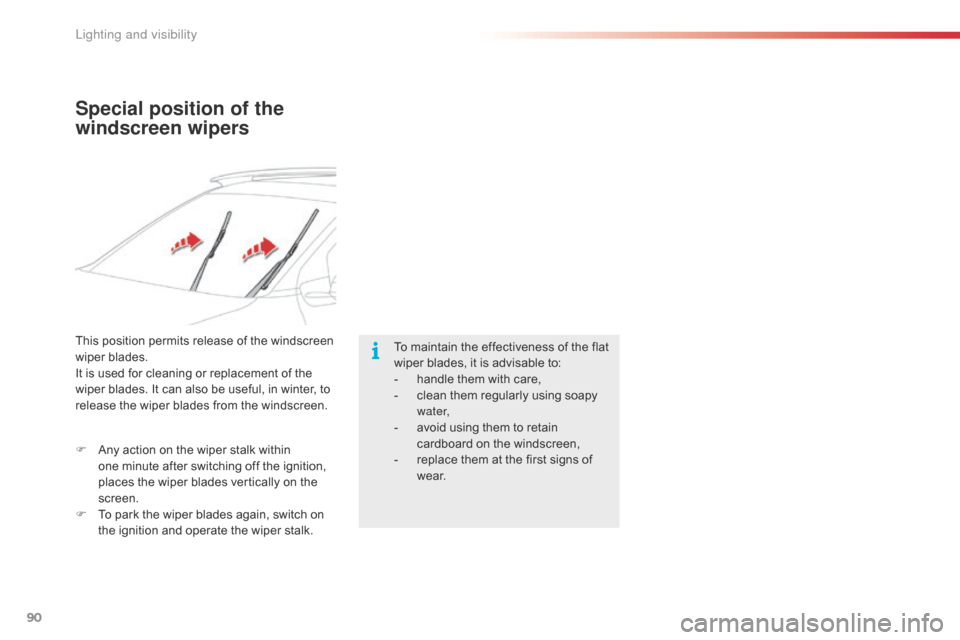
90
Special position of the
windscreen wipers
Toô maintainô theô effectivenessô ofô theô flatô wiper ô blades, ô it ô is ô advisable ô to:
-
ô
h
andle ô them ô with ô care,
-
ô
c
lean ô them ô regularly ô using ô soapy ô
w
ater,
-
ô
a
void ô using ô them ô to ô retain ô
c
ardboard ô on ô the ô windscreen,
-
ô
r
eplace ô them ô at ô the ô first ô signs ô of ô
w
e a r.
This
ô
position
ô
permits
ô
release
ô
of
ô
the
ô
windscreen
ô w
iper
ô
blades.
It
ô
is
ô
used
ô
for
ô
cleaning
ô
or
ô
replacement
ô
of
ô
the
ô
w
iper
ô
blades.
ô
It
ô
can
ô
also
ô
be
ô
useful,
ô
in
ô
winter,
ô
to
ô
r
elease
ô
the
ô
wiper
ô
blades
ô
from
ô
the
ô
windscreen.
F
ô
A
ny
ô
action
ô
on
ô
the
ô
wiper
ô
stalk
ô
within
ô
o
neô minute
ô
after
ô
switching
ô
off
ô
the
ô
ignition,
ô
p
laces
ô
the
ô
wiper
ô
blades
ô
vertically
ô
on
ô
the
ô
sc
reen.
F
ô
T
o
ô
park
ô
the
ô
wiper
ô
blades
ô
again,
ô
switch
ô
on
ô
t
he
ô
ignition
ô
and
ô
operate
ô
the
ô
wiper
ô
stalk.
Lighting and visibility
Page 93 of 308
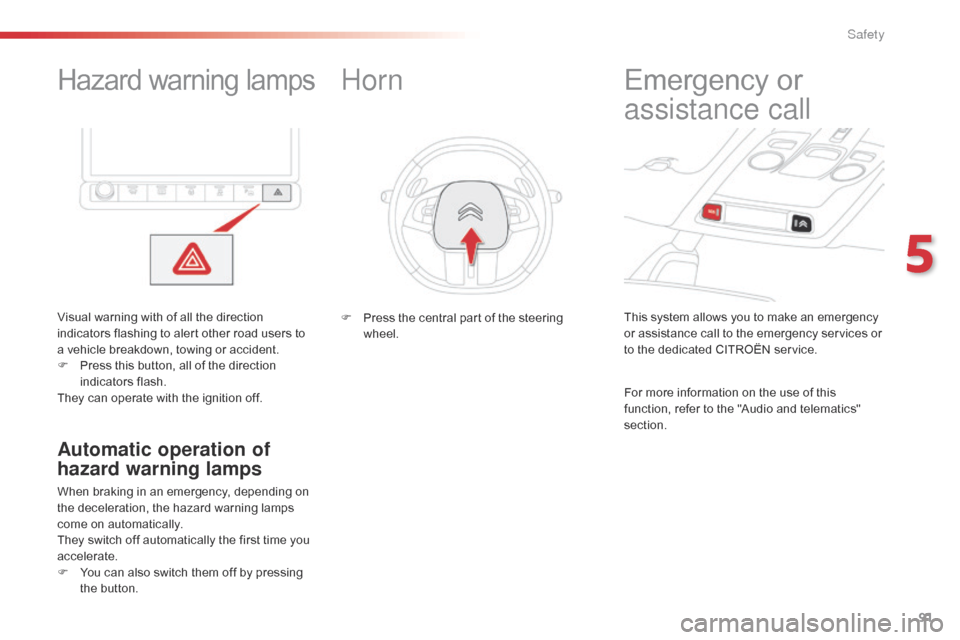
91
Hazardô warningô lamps
Visualô warningô withô ofô allô theô directionô i
ndicators ô flashing ô to ô alert ô other ô road ô users ô to ô
aô v
ehicle ô breakdown, ô towing ô or ô accident.
F
ô
P
ress ô this ô button, ô all ô of ô the ô direction ô
in
dicators
ô f
lash.
They
ô can ô operate ô with ô the ô ignition ô off.
Automatic operation of
hazard warning lamps
Whenô brakingô inô anô emergency,ô dependingô onô the ô deceleration, ô the ô hazard ô warning ô lamps ô
c
ome ô on ô automatically.
They
ô switch ô off ô automatically ô the ô first ô time ô you ô
a
ccelerate.
F
ô
Y
ou ô can ô also ô switch ô them ô off ô by ô pressing ô
t
he ô button. This
ô system ô allows ô you ô to ô make ô an ô emergency ô
o
r ô assistance ô call ô to ô the ô emergency ô services ô or ô
t
o ô the ô dedicated ô CITROûN ô service.
Emergencyô o
rô
a
ssistance call
Forô moreô informationô onô theô useô ofô thisô f
unction, ô refer ô to ô the ô "Audio ô and ô telematics" ô
s
ection.
Horn
Fô Press ô the ô central ô part ô of ô the ô steering ô w
heel.
5
Safety
Page 94 of 308
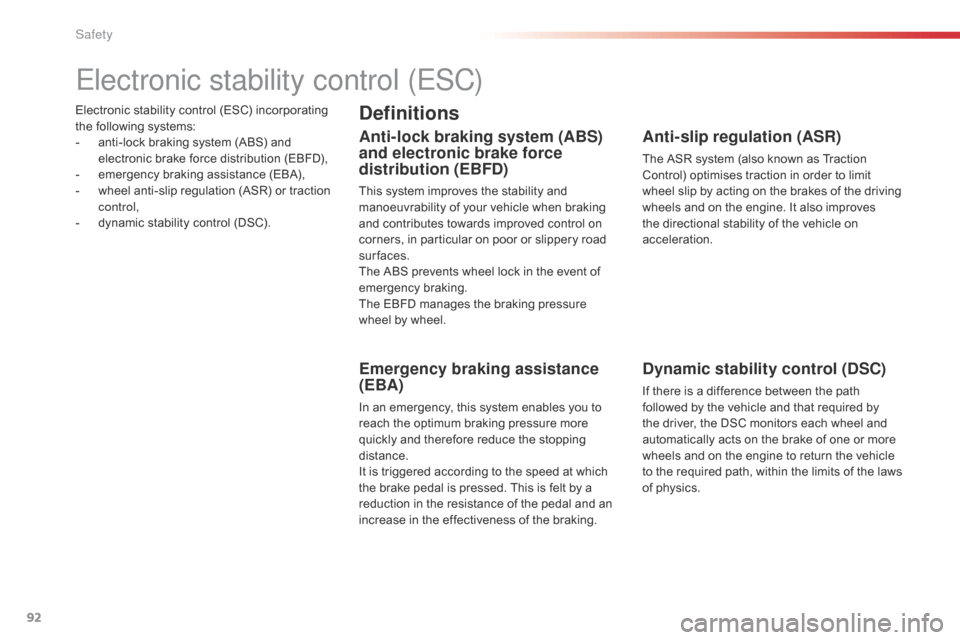
92
Electronicô stabilityô controlô (ESC)ô incorporatingô the ô following ô systems:
-
ô
a
nti-lock ô braking ô system ô (ABS) ô and ô
e
lectronic ô brake ô force ô distribution ô (EBFD),
-
ô
e
mergency ô braking ô assistance ô (EBA),
-
ô
w
heel ô anti-slip ô regulation ô (ASR) ô or ô traction ô
c
ontrol,
-
ô
d
ynamic ô stability ô control ô (DSC).
Electronic stability control (ESC)
Definitions
Anti-lock braking system (ABS)
and electronic brake force
distribution (EBFD)
Thisô systemô improvesô theô stabilityô andô manoeuvrability ô of ô your ô vehicle ô when ô braking ô
a
nd ô contributes ô towards ô improved ô control ô on ô
c
orners, ô in ô particular ô on ô poor ô or ô slippery ô road ô
su
rfaces.
The
ô ABS ô prevents ô wheel ô lock ô in ô the ô event ô of ô
em
ergency
ô b
raking.
The
ô EBFD ô manages ô the ô braking ô pressure ô
w
heel ô by ô wheel.
Emergency braking assistance
(EBA)
Inô anô emergency,ô thisô systemô enablesô youô toô reach ô the ô optimum ô braking ô pressure ô more ô
q
uickly ô and ô therefore ô reduce ô the ô stopping ô
di
stance.
It
ô is ô triggered ô according ô to ô the ô speed ô at ô which ô
t
he ô brake ô pedal ô is ô pressed. ô This ô is ô felt ô by ô a ô
r
eduction ô in ô the ô resistance ô of ô the ô pedal ô and ô an ô
i
ncrease ô in ô the ô effectiveness ô of ô the ô braking.
Anti-slip regulation (ASR)
Theô ASRô systemô (alsoô knownô asô Tractionô Control) ô optimises ô traction ô in ô order ô to ô limit ô
w
heel ô slip ô by ô acting ô on ô the ô brakes ô of ô the ô driving ô
w
heels ô and ô on ô the ô engine. ô It ô also ô improves ô
t
he ô directional ô stability ô of ô the ô vehicle ô on ô
a
cceleration.
Dynamic stability control (DSC)
Ifô thereô isô aô differenceô betweenô theô pathô followed ô by ô the ô vehicle ô and ô that ô required ô by ô
t
he ô driver, ô the ô DSC ô monitors ô each ô wheel ô and ô
a
utomatically ô acts ô on ô the ô brake ô of ô one ô or ô more ô
w
heels ô and ô on ô the ô engine ô to ô return ô the ô vehicle ô
t
o ô the ô required ô path, ô within ô the ô limits ô of ô the ô laws ô
o
f ô physics.
Safety
Page 95 of 308
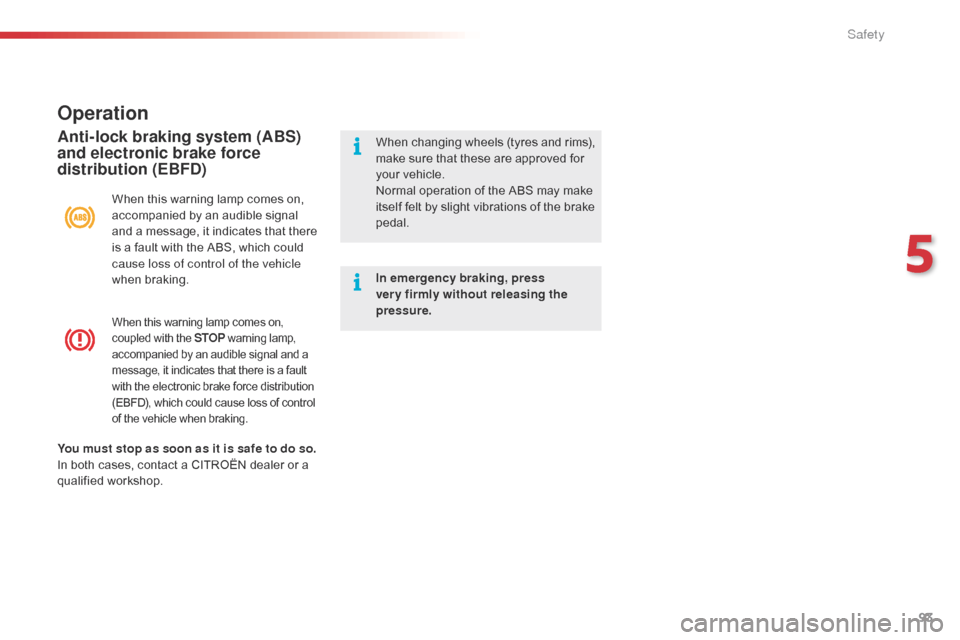
93
Whenô thisô warningô lampô comesô on,ô coupled ô with ô the ô STOPô w arningô lam p,ô a
ccompanied ô by ô an ô audible ô signal ô and ô a
ô m
essage, ô it ô indicates ô that ô there ô is ô a ô fault
ô w
ith ô the ô electronic ô brake ô force ô distribution
ô (
EBFD), ô which ô could ô cause ô loss ô of ô control
ô o
f ô the ô vehicle ô when ô braking.
Operation
Whenô thisô warningô lampô comesô on,ô accompanied ô by ô an ô audible ô signal ô
a
nd ô a ô message, ô it ô indicates ô that ô there ô
i
s ô a ô fault ô with ô the ô ABS, ô which ô could ô
c
ause loss of control of the vehicle
when
ô b
raking.
Anti-lock braking system (ABS)
and electronic brake force
distribution (EBFD)Whenô changing ô w heels ô ( tyres ô a nd ô r ims), ô m
ake ô sure ô that ô these ô are ô approved ô for ô
y
our ô vehicle.
Normal
ô operation ô of ô the ô ABS ô may ô make ô
i
tself ô felt ô by ô slight ô vibrations ô of ô the ô brake ô
ped
al.
In emergency braking, press
very firmly without releasing the
pressure.
You must stop as soon as it is safe to do so.
In
ô
both
ô
cases,
ô
contact
ô
a
ô
CITROûN
ô
dealer
ô
or
ô
a
ô
q
ualified
ô w
orkshop.
5
Safety
Page 96 of 308
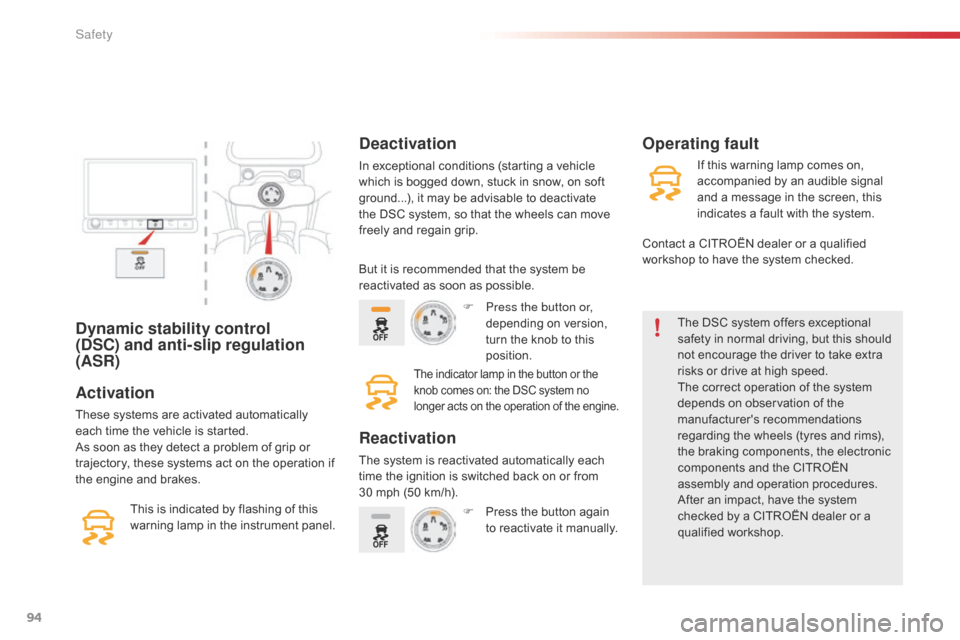
94
Dynamic stability control
(DSC) and anti-slip regulation
(ASR)Theô DSCô systemô offersô exceptionalô safety ô in ô normal ô driving, ô but ô this ô should ô
n
ot ô encourage ô the ô driver ô to ô take ô extra ô
r
isks ô or ô drive ô at ô high ô speed.
The
ô correct ô operation ô of ô the ô system ô
d
epends ô on ô observation ô of ô the ô
ma
nufacturer's
ô r
ecommendations
ô r
egarding ô the ô wheels ô (tyres ô and ô rims), ô
t
he ô braking ô components, ô the ô electronic ô
c
omponents ô and ô the ô CITROûN ô
a
ssembly ô and ô operation ô procedures.
After
ô an ô impact, ô have ô the ô system ô
c
hecked ô by ô a ô CITROûN ô dealer ô or ô a ô
q
ualified
ô w
orkshop.
Activation
Theseô systemsô areô activatedô automaticallyô each ô time ô the ô vehicle ô is ô started.
As
ô soon ô as ô they ô detect ô a ô problem ô of ô grip ô or ô
t
rajectory, ô these ô systems ô act ô on ô the ô operation ô if ô
t
he ô engine ô and ô brakes.
Deactivation
Inô exceptionalô conditionsô (startingô aô vehicleô which ô is ô bogged ô down, ô stuck ô in ô snow, ô on ô soft ô
g
round...), ô it ô may ô be ô advisable ô to ô deactivate ô
t
he ô DSC ô system, ô so ô that ô the ô wheels ô can ô move ô
f
reely ô and ô regain ô grip.
This
ô
is
ô
indicated
ô
by
ô
flashing
ô
of
ô
this
ô
w
arning
ô
lamp
ô
in
ô
the
ô
instrument
ô
panel.
Operating fault
Butô itô isô recommendedô thatô theô systemô beô r eactivated ô as ô soon ô as ô possible.
F
P
ress the button or,
depending
ô on ô version, ô
t
urn ô the ô knob ô to ô this ô
p
osition.
Theô indicatorô lampô inô theô buttonô orô theô knob ô comes ô on: ô the ô DSC ô system ô noô l
onger ô acts ô on ô the ô operation ô of ô the ô engine.
Reactivation
Theô systemô isô reactivatedô automaticallyô eachô time ô the ô ignition ô is ô switched ô back ô on ô or ô from ô
3
0ô mph ô (50 ô km/h).F
ô
P
ress ô the ô button ô again ô
t
o ô reactivate ô it ô manually.If
ô this ô warning ô lamp ô comes ô on, ô
a
ccompanied ô by ô an ô audible ô signal ô
a
nd ô a ô message ô in ô the ô screen, ô this ô
i
ndicates ô a ô fault ô with ô the ô system.
Contact ô a ô CITROûN ô dealer ô or ô a ô qualified ô
w
orkshop ô to ô have ô the ô system ô checked.
Safety
Page 97 of 308
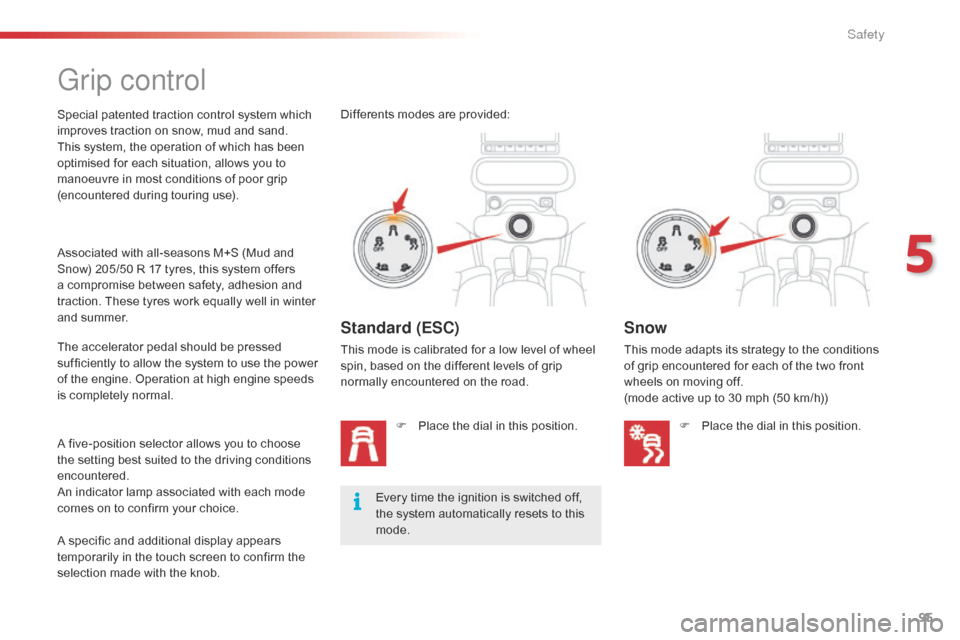
95
Grip control
Specialô patentedô tractionô controlô systemô whichô improves ô traction ô on ô snow, ô mud ô and ô sand.
This
ô system, ô the ô operation ô of ô which ô has ô been ô
o
ptimised ô for ô each ô situation, ô allows ô you ô to ô
m
anoeuvre ô in ô most ô conditions ô of ô poor ô grip ô
(
encountered
ô d
uring
ô t
ouring
ô u
se).
The
ô accelerator ô pedal ô should ô be ô pressed ô
s
ufficiently ô
t
o ô
a
llow ô
t
he ô
s
ystem ô
t
o ô
u
se ô
t
he ô
p
ower ô
o
f ô the ô engine. ô Operation ô at ô high ô engine ô speeds ô
i
s ô completely ô normal.
Associated
ô with ô all-seasons ô M+S ô (Mud ô and ô
S
now) ô 205/50 ô R ô 17 ô tyres, ô this ô system ô offers ô
a
ô compromise ô between ô safety, ô adhesion ô and ô
t
raction. ô These ô tyres ô work ô equally ô well ô in ô winter ô
a
nd ô summer.
A
ô five-position ô selector ô allows ô you ô to ô choose ô
t
he ô setting ô best ô suited ô to ô the ô driving ô conditions ô
en
countered.
An
ô indicator ô lamp ô associated ô with ô each ô mode ô
c
omes ô on ô to ô confirm ô your ô choice.
A
ô specific ô and ô additional ô display ô appears ô
t
emporarily ô in ô the ô touch ô screen ô to ô confirm ô the ô
s
election ô made ô with ô the ô knob. Every
ô time ô the ô ignition ô is ô switched ô off, ô
t
he ô system ô automatically ô resets ô to ô this ô
m
ode.
Differents
ô modes ô are ô provided:
Standard (ESC)
Thisô modeô isô calibratedô forô aô lowô levelô ofô wheelô s
pin, ô based ô on ô the ô different ô levels ô of ô grip ô
n
ormally ô encountered ô on ô the ô road.
F
ô
P
lace ô the ô dial ô in ô this ô position.
Snow
Thisô modeô adaptsô itsô strategyô toô theô conditionsô of ô grip ô encountered ô for ô each ô of ô the ô two ô front ô
w
heels ô on ô moving ô off.
(mode
ô active ô up ô to ô 30 ô mph ô (50 ô km/h))
F
ô
P
lace ô the ô dial ô in ô this ô position.
5
Safety
Page 98 of 308

96
Driving advice
Yourô vehicleô isô designedô principallyô toô drive ô on ô tarmac ô roads ô but ô it ô allows ô you ô
t
o ô drive ô on ô other ô less ô passable ô terrain ô
o
ccasionally.
However,
ô it ô does ô not ô permit ô off-road ô
d
riving ô such ô as:
-
ô
c
rossing ô and ô driving ô on ô terrain ô
w
hich ô could ô damage ô the ô underbody ô
o
r ô strip ô away ô components ô (fuel ô
p
ipe, ô fuel ô cooler...) ô due ô to ô obstacles ô
o
r stones in particular,
-
ô
d
riving ô on ô terrain ô with ô steep ô
g
radients ô and ô poor ô grip,
-
ô
c
rossing ô a ô stream.All terrain (mud, damp grass, ...)
Thisô mode,ô whenô movingô off,ô allowsô considerable ô spin ô on ô the ô wheel ô with ô the ô least ô
g
rip ô to ô optimise ô clearing ô of ô the ô mud ô and ô regain ô
g
rip. ô At ô the ô same ô time, ô the ô wheel ô with ô the ô most ô
g
rip ô is ô controlled ô in ô such ô a ô way ô as ô to ô pass ô as ô
m
uch ô torque ô as ô possible.
When
ô moving, ô the ô system ô optimises ô wheel ô spin ô
t
o ô respond ô to ô the ô driver's ô requirements ô as ô fully ô
a
s ô possible.
(mode
ô active ô up ô to ô 50 ô mph ô (80 ô km/h))
F
ô
P
lace ô the ô dial ô in ô this ô position.
Sand
Thisô modeô allowsô littleô spinô onô theô twoô drivingô wheels ô at ô the ô same ô time ô to ô allow ô the ô vehicle ô to ô
m
ove ô for ward ô and ô limit ô the ô risks ô of ô getting ô stuck ô
i
n ô the ô sand.
(mode
ô active ô up ô to ô 75 ô mph ô (120 ô km/h))
F
ô
P
lace ô the ô dial ô in ô this ô position.
Do
ô not ô use ô the ô other ô modes ô on ô sand ô as ô the ô
v
ehicle ô may ô become ô stuck. You
ô can ô deactivate ô certain ô functions ô of ô the ô
ES
C ô (ASR ô and ô DSC) ô by ô turning ô the ô dial ô to ô the ô
"
O
FF
" ô position.
These ô functions ô are ô reactivated ô automatically ô
f
rom ô 30 ô mph ô (50 ô km/h) ô or ô every ô time ô the ô
i
gnition ô is ô switched ô back ô on.
Safety
Page 99 of 308
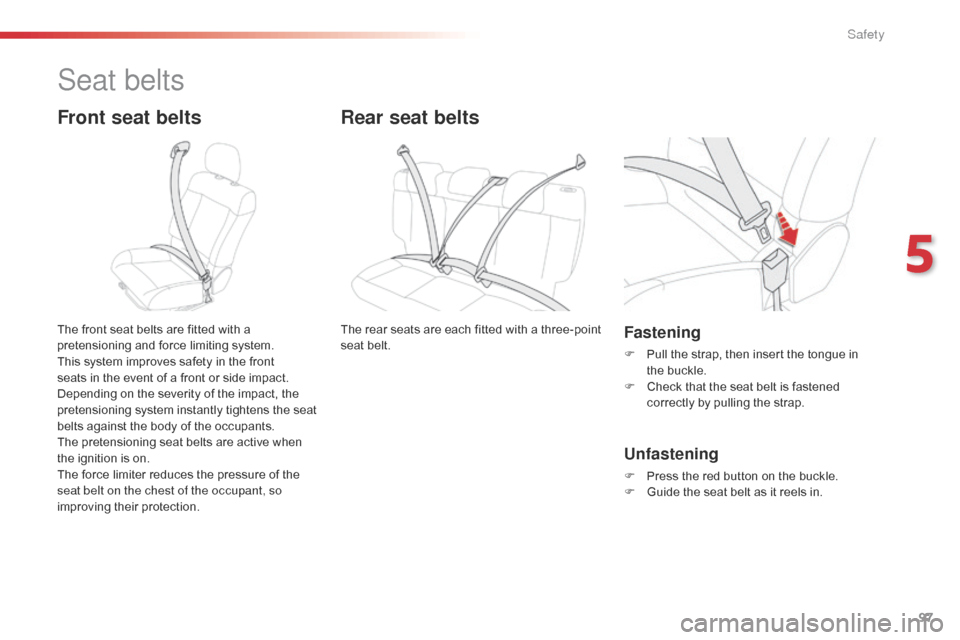
97
Seat belts
Front seat belts
Theô frontô seatô beltsô areô fittedô withô aô pretensioning ô and ô force ô limiting ô system.
This
ô system ô improves ô safety ô in ô the ô front ô
s
eats ô in ô the ô event ô of ô a ô front ô or ô side ô impact. ô
D
epending ô on ô the ô severity ô of ô the ô impact, ô the ô
p
retensioning ô system ô instantly ô tightens ô the ô seat ô
b
elts ô against ô the ô body ô of ô the ô occupants.
The
ô pretensioning ô seat ô belts ô are ô active ô when ô
t
he ô ignition ô is ô on.
The
ô force ô limiter ô reduces ô the ô pressure ô of ô the ô
s
eat belt on the chest of the occupant, so
improving
ô their ô protection.Fastening
Fô Pullô the ô strap, ô then ô insert ô the ô tongue ô in ô t
heô buckle.
F
ô
C
heck ô that ô the ô seat ô belt ô is ô fastened ô
c
orrectly ô by ô pulling ô the ô strap.
Unfastening
Fô Pressô the ô red ô button ô on ô the ô buckle.
F ô G uide ô the ô seat ô belt ô as ô it ô reels ô in.
Rear seat belts
Theô rearô seatsô areô eachô fittedô withô aô three-pointô seat ô belt.
5
Safety
Page 100 of 308
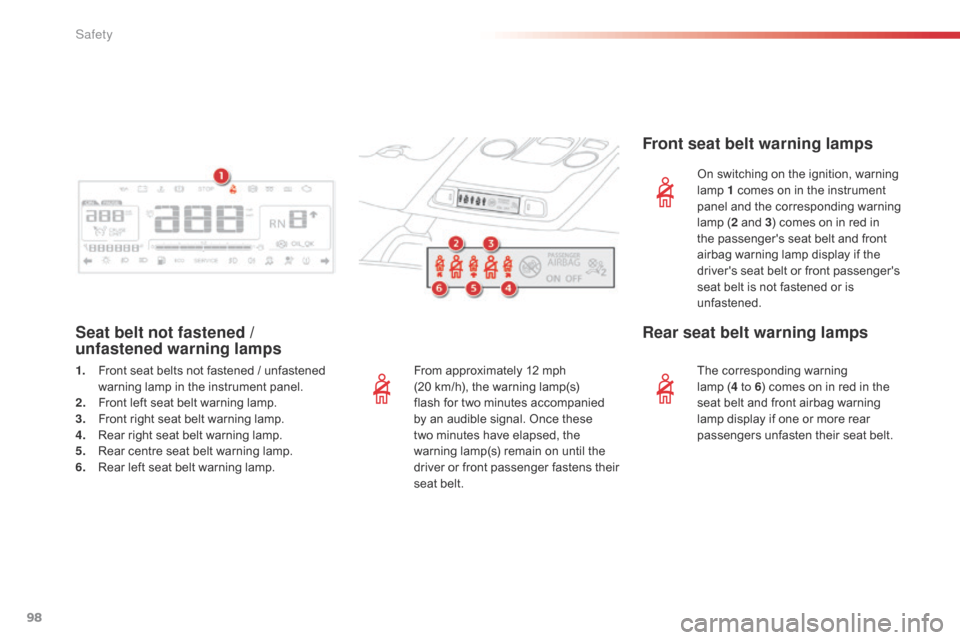
98
Fromô approximatelyô 12ô mphô (20ô km/h), ô the ô warning ô lamp(s) ô
f
lash ô for ô two ô minutes ô accompanied ô
b
y ô an ô audible ô signal. ô Once ô these ô
t
woô minutes ô have ô elapsed, ô the ô
w
arning ô lamp(s) ô remain ô on ô until ô the ô
d
river ô or ô front ô passenger ô fastens ô their ô
s
eat ô belt.
Seat belt not fastened /
unfastened warning lamps Front seat belt warning lamps
Onô switchingô onô theô ignition,ô warningô lam
pô 1 ô comes ô on ô in ô the ô instrument ô
p
anel ô and ô the ô corresponding ô warning ô
l
amp ô (2
ô and ô 3)
ô comes ô on ô in ô red ô in ô
t
he ô passenger's ô seat ô belt ô and ô front ô
a
irbag ô warning ô lamp ô display ô if ô the ô
d
river's ô seat ô belt ô or ô front ô passenger's ô
s
eat ô belt ô is ô not ô fastened ô or ô is ô
u
nfastened.
1.
ô F
ront
ô
seat
ô
belts
ô
not
ô
fastened
ô
/
ô
unfastened
ô
w
arning
ô
lamp
ô
in
ô
the
ô
instrument
ô
panel.
2.
ô F
ront
ô
left
ô
seat
ô
belt
ô
warning
ô
lamp.
3.
ô F
ront
ô
right
ô
seat
ô
belt
ô
warning
ô
lamp.
4.
ô R
ear
ô
right
ô
seat
ô
belt
ô
warning
ô
lamp.
5.
ô R
ear
ô
centre
ô
seat
ô
belt
ô
warning
ô
lamp.
6.
ô R
ear
ô
left
ô
seat
ô
belt
ô
warning
ô
lamp.
Rear seat belt warning lamps
Theô correspondingô warningô l ampô ( 4
to 6)
ô comes ô on ô in ô red ô in ô the ô
s
eat ô belt ô and ô front ô airbag ô warning ô
l
amp ô display ô if ô one ô or ô more ô rear ô
p
assengers
ô u
nfasten
ô t
heir
ô sea
t
ô b
elt.
Safety